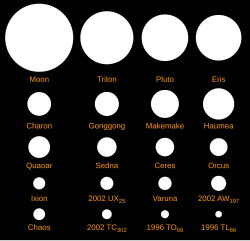19521 Chaos: Difference between revisions
Content deleted Content added
replace {{val2}} with {{val}} per Wikipedia:Templates for discussion/Log/2014 February 7#Template:Val2 |
Kwamikagami (talk | contribs) MOS fmt using AWB |
||
| Line 28: | Line 28: | ||
|mean_anomaly = {{val|324.2844|u=°}} |
|mean_anomaly = {{val|324.2844|u=°}} |
||
|avg_speed = {{val|4.3931|u=km/s}} |
|avg_speed = {{val|4.3931|u=km/s}} |
||
|dimensions = {{val|600|140| |
|dimensions = {{val|600}} {{±|140|130}} km<ref name=TNOsCool6>[http://arxiv.org/pdf/1204.0697v1.pdf “TNOs are Cool”: A survey of the trans-Neptunian region VI. Herschel/PACS observations and thermal modeling of 19 classical Kuiper belt objects] E. Vilenius, C. Kiss, M. Mommert, T. Müller, P. Santos-Sanz, A. Pal, J. Stansberry, M. Mueller, N. Peixinho, S. Fornasier, E. Lellouch, A. Delsanti, A. Thirouin, J. L. Ortiz, R. Duffard, D. Perna, N. Szalai, S. Protopapa, F. Henry, D. Hestroffer, M. Rengel, E. Dotto, & P. Hartogh</ref> |
||
|mass = |
|mass = |
||
|density = |
|density = |
||
Revision as of 13:31, 23 February 2014
| Discovery | |
|---|---|
| Discovered by | Deep Ecliptic Survey |
| Discovery date | November 19, 1998 |
| Designations | |
Designation | 19521 Chaos |
| Pronunciation | /ˈkeɪ.ɒs/ |
Named after | Chaos |
| 1998 WH24 | |
| TNO (cubewano)[1] | |
| Adjectives | Chaotian |
| Orbital characteristics[2] | |
| Epoch January 30, 2005 (JD 2453400.5) | |
| Aphelion | 50.269 AU |
| Perihelion | 40.929 AU |
| 45.599 AU | |
| Eccentricity | 0.102 |
| 309.1006 y | |
Average orbital speed | 4.3931 km/s |
| 324.2844° | |
| Inclination | 12.0550° |
| 50.0103° | |
| 58.6836° | |
| Physical characteristics | |
| Dimensions | 600 +140 −130 km[3] |
| 3.985 d | |
| Albedo | 0.050+0.030 −0.016[3] |
| 4.9[2] | |
19521 Chaos /ˈkeɪ.ɒs/, is a cubewano, a Kuiper-belt object not in resonance with any planet. It is a likely dwarf planet. Chaos was discovered in 1998 by the Deep Ecliptic Survey, with Kitt Peak's 4 m telescope. Its albedo is 0.050+0.030
−0.016,[3] making it, with its absolute magnitude (H) of 4.9,[2] 600+140
−130 km in diameter.[3] It is named after the primeval state of existence in Greek mythology, from which the first gods appeared.
References
- ^ Marc W. Buie (2004-11-09). "Orbit Fit and Astrometric record for 19521". SwRI (Space Science Department). Retrieved 2008-09-28.
- ^ a b c "JPL Small-Body Database Browser: 19521 Chaos (1998 WH24)". 2007-12-14 last obs. Retrieved 2010-03-13.
{{cite web}}: Check date values in:|date=(help) - ^ a b c d “TNOs are Cool”: A survey of the trans-Neptunian region VI. Herschel/PACS observations and thermal modeling of 19 classical Kuiper belt objects E. Vilenius, C. Kiss, M. Mommert, T. Müller, P. Santos-Sanz, A. Pal, J. Stansberry, M. Mueller, N. Peixinho, S. Fornasier, E. Lellouch, A. Delsanti, A. Thirouin, J. L. Ortiz, R. Duffard, D. Perna, N. Szalai, S. Protopapa, F. Henry, D. Hestroffer, M. Rengel, E. Dotto, & P. Hartogh
External links
- Orbital simulation from JPL (Java) / Horizons Ephemeris

